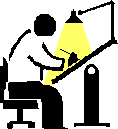|
|
|
|
|
|

|
|
|
|
STEP
1: |
|
One
of the "Big Three
Problems" assigned to me by my new boss, then the Vice
President of Marketing at IPeria, was to cut printing costs and speed up
production turnaround. I
contacted
a printer's account rep with whom I had worked for years, and knew that he had moved from his previous employer to
top-flight Synergy Graphics
(they definitely earned this link!).
I called and explained the
situation. He had extensive experience in the creative process as well as
printing technology. Before he became a printing rep, he ran his own ad agency for years.
He immediately assessed IPeria's situation, and recommended that we utilize Synergy's brand-new Heidelberg direct-to-plate printing press, one of a handful of these state-of-the-art units in the country. The Heidelberg would allow us to print standard letter-size, 4-color, 2-sided data sheets (termed "4/4" printing in the trade) two-up, or 11 x 17 inch tabloid-size brochures in smaller quantities than would have been economical on a conventional 4-color press. As a bonus, the direct-to-plate process eliminated the delay and cost of expensive press proofs. Because we needed only several hundred pieces at a time and needed them fast, this was an ideal solution for us. RESULT. IPeria was able to economically print short runs at about $1,100 per thousand 4/4 tabloid sheets (each sheet could contain one brochure or, after cutting, two data sheets) with normal turnaround of less than 2 days without rush charges! |
|
|
|
|
 |
STEP 2: |
|
As
the health of the telecommunications industry declined and IPeria faced
increasing sales resistance by telcom customer prospects, venture
capital began to become more difficult to obtain. To further cut
overhead costs, I took all collateral printing completely in-house. Our
printing press would be the firm's Xerox DocuColor 4-color laser
printer, already being leased. I had used the DocuColor printer to
produce signage and PowerPoint handouts.
I knew DocuColor machines served as the production engines for numerous quick-print shops I had contracted in previous jobs and ours potentially was up to the task. Unfortunately, it had been long neglected and was sorely in need of service and adjustment. I summoned one tech support person after another through the leasing company (at no cost to IPeria) until the $26,000 top-of-the-line printer was operating to its fine design specifications. There was one final detail to work out -- the paper stock. Synergy Graphics had been printing our data sheets and brochures on premium Kromekote 100-pound cover stock. However, Kromekote can melt in the hot Xerox copier environment. Oops! I researched laser-friendly paper stocks that were similar in characteristics, and selected an inexpensive 80-pound near look-alike from Wausau Paper Mills called Exact Coated. I purchased several boxes of reams of letter and tabloid size sheets from a distributor. Cost to IPeria -- only about $135 for a projected year's supply! RESULT. IPeria maintained perceived printing quality, eliminated outside printing costs, and could generate freshly revised collateral materials on demand in minutes! |
|
|
Copyright © 2002-8 Leonard A. Phillips, 43 Main Street, Acton MA 01720
|
|
Copyright © 2002-8 Leonard A. Phillips, 43 Main Street, Acton MA 01720